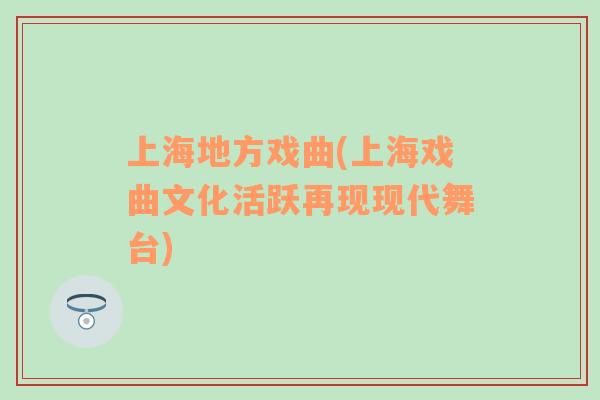秋季旅游鞋(秋季旅游鞋推荐舒适时尚陪你走遍金色大地)
随着秋季的到来,树叶渐渐染上金色,空气中弥漫着丰收的气息,正是出游的好时节。而在这美好的季节里,一双合适的旅游旅游广告语大全鞋不仅...
扫一扫用手机浏览
Shanghai traditional opera, also known as "huju", is one of the most famous and representative traditional operas in China. With its unique characteristics and charm, it has a profound influence on the development of Chinese opera art. In recent years, the Shanghai government has attached great importance to the preservation and promotion of Shanghai traditional opera culture, and many efforts have been made to revitalize this traditional art form on the modern stage.

Shanghai traditional opera originated in the mid-19th century, during the late Qing Dynasty. The opera form was heavily influenced by the local dialect of Shanghai, called "Shanghainese". At first, it was a form of street performance, but later developed into a popular form of entertainment in teahouses and other public places. Shanghai traditional opera experienced a golden age during the 1920s and 1930s, when many famous playwrights, actors, and directors emerged. However, it declined in popularity after the establishment of the People's Republic of China in 1949, due to the political climate and social changes that followed.
Since the 1990s, the Shanghai government has made significant efforts to revitalize the local traditional opera culture. In 2002, the Shanghai Huju Opera Troupe was established, and the Shanghai Huju Opera Museum was opened to the public in 2005. These institutions have played an important role in preserving and promoting this art form. In addition, the government has invested in training young actors and artists, promoting and organizing performances, and supporting the study and research of Shanghai traditional opera culture.
While traditional performances still exist, many modern adaptations of Shanghai traditional opera have emerged. These adaptations often combine traditional elements with contemporary ideas and techniques, making the art form more accessible to younger generations. For example, the Huju Opera "The Wilderness" was adapted and performed by the Shanghai Jingju Theatre Company in 2019, using modern stage technology and incorporating elements of rock music and martial arts.
Despite the efforts to revitalize Shanghai traditional opera, challenges remain. The art form still faces the threat of extinction due to the decline in popularity and the aging of the audience. Therefore, it is important to find new ways to popularize the art form and attract younger audiences. At the same time, it is essential to preserve the traditional heritage and pass it on to future generations through education and cultural heritage protection mechanisms.
Shanghai traditional opera is an important element of the city's culture and a national treasure of China. The efforts made by the Shanghai government and artists to revitalize the traditional opera culture have helped to preserve and promote this unique art form. However, more work needs to be done to preserve and pass on the heritage to future generations. The modern adaptations, with their innovative twists and turns, offer a potential solution to attract a wider audience and revive interest in this traditional art form.